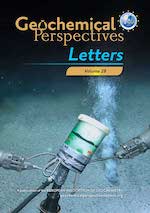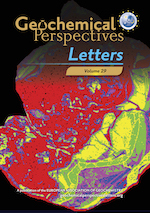The end of the isotopic evolution of atmospheric xenon
Affiliations | Corresponding Author | Cite as | Funding information- Share this article





-
Article views:2,465Cumulative count of HTML views and PDF downloads.
- Download Citation
- Rights & Permissions
top
Abstract
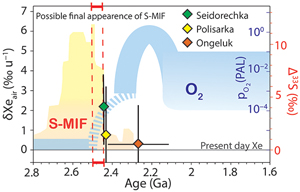
Figures and Tables
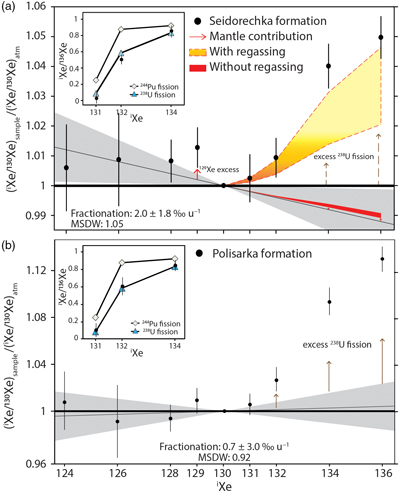 Figure 1 Isotopic spectrum of Xe released from fluid inclusions in (a) sample FD1A and (b) sample FD3A. The grey line and its associated envelope (2σ) correspond to the isotopic trend of the 124,126,128,130Xe. (a) Mantle excesses of 131,132,134,136Xe are estimated using the 129Xe excess (Supplementary Information). Individual error bars are at 2σ. | 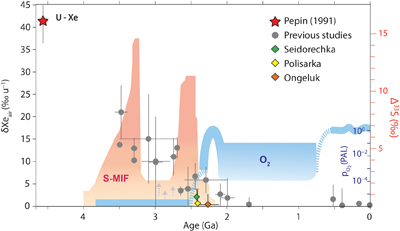 Figure 2 Records of atmospheric oxygen (O2, blue; Lyons et al., 2014), mass-independent fractionation of sulfur isotopes (MIF-S, orange; data from Killingsworth et al., 2019) and mass dependent fractionation of xenon isotopes throughout Earth’s history (Pepin, 1991; Avice et al., 2018; Almayrac et al., 2021), uncertainties are at 2σ. |  Table 1 Isotopic ratio of the noble gases released by crushing and Xe fractionation. The fractionation was calculated from the 124,126,128Xe/130Xe ratios. The ratios are the weighted average of several replicates (Table S-3). |
| Figure 1 | Figure 2 | Table 1 |
top
Introduction
Due to their chemical inertness, noble gases (He, Ne, Ar, Kr, Xe) constitute powerful geochemical tracers for constraining physical processes occurring in the Earth’s atmosphere. Atmospheric xenon is of particular interest because its isotopic composition is highly mass-dependently fractionated (MDF) by 41.5 ‰ u−1 when compared to its presumed primitive ancestor U-Xe (Pepin, 1991
Pepin, R.O. (1991) On the origin and early evolution of terrestrial planet atmospheres and meteoritic volatiles. Icarus 92, 2–79. https://doi.org/10.1016/0019-1035(91)90036-S
). Studies of palaeo-atmospheric Xe trapped in Archaean rocks (mainly as fluid inclusions in hydrothermal quartz) have shown that the evolution of isotopic fractionation of Xe was a long-term process that took place during the Hadean and the Archaean aeons. This protracted MDF appears to be unique to Xe, with no evidence that the other noble gases underwent progressive fractionation (Pujol et al., 2011Pujol, M., Marty, B., Burgess, R. (2011) Chondritic-like xenon trapped in Archean rocks: A possible signature of the ancient atmosphere. Earth and Planetary Science Letters 308, 298–306. https://doi.org/10.1016/j.epsl.2011.05.053
; Avice et al., 2018Avice, G., Marty, B., Burgess, R., Hofmann, A., Philippot, P., Zahnle, K., Zakharov, D. (2018) Evolution of atmospheric xenon and other noble gases inferred from Archean to Paleoproterozoic rocks. Geochimica et Cosmochimica Acta 232, 82–100. https://doi.org/10.1016/j.gca.2018.04.018
; Almayrac et al., 2021Almayrac, M.G., Broadley, M.W., Bekaert, D.V., Hofmann, A., Marty, B. (2021) Possible discontinuous evolution of atmospheric xenon suggested by Archean barites. Chemical Geology 581, 120405. https://doi.org/10.1016/j.chemgeo.2021.120405
). Such Xe specific evolution has been attributed to preferential, non-thermal escape of xenon from the Earth’s atmosphere to space upon ionisation by solar UV photons (Pujol et al., 2011Pujol, M., Marty, B., Burgess, R. (2011) Chondritic-like xenon trapped in Archean rocks: A possible signature of the ancient atmosphere. Earth and Planetary Science Letters 308, 298–306. https://doi.org/10.1016/j.epsl.2011.05.053
; Hébrard and Marty, 2014Hébrard, E., Marty, B. (2014) Coupled noble gas–hydrocarbon evolution of the early Earth atmosphere upon solar UV irradiation. Earth and Planetary Science Letters 385, 40–48. https://doi.org/10.1016/j.epsl.2013.10.022
; Avice et al., 2018Avice, G., Marty, B., Burgess, R., Hofmann, A., Philippot, P., Zahnle, K., Zakharov, D. (2018) Evolution of atmospheric xenon and other noble gases inferred from Archean to Paleoproterozoic rocks. Geochimica et Cosmochimica Acta 232, 82–100. https://doi.org/10.1016/j.gca.2018.04.018
) and subsequent entrainment by escaping hydrogen ions (Zahnle et al., 2019Zahnle, K.J., Gacesa, M., Catling, D.C. (2019) Strange messenger: A new history of hydrogen on Earth, as told by Xenon. Geochimica et Cosmochimica Acta 244, 56–85. https://doi.org/10.1016/j.gca.2018.09.017
). Available data indicate that the evolution of the isotopic composition of atmospheric xenon ceased at some point between 2.6 and 1.8 Ga (Avice et al., 2018Avice, G., Marty, B., Burgess, R., Hofmann, A., Philippot, P., Zahnle, K., Zakharov, D. (2018) Evolution of atmospheric xenon and other noble gases inferred from Archean to Paleoproterozoic rocks. Geochimica et Cosmochimica Acta 232, 82–100. https://doi.org/10.1016/j.gca.2018.04.018
).Xenon is the second atmospheric element for which a stable isotope fractionation during the Archaean aeon has been observed, with the mass-independent fractionation of sulfur isotopes (MIF-S) being characteristic for Archaean age samples (Farquhar and Wing, 2003
Farquhar, J., Wing, B.A. (2003) Multiple sulfur isotopes and the evolution of the atmosphere. Earth and Planetary Science Letters 213, 1–13. https://doi.org/10.1016/S0012-821X(03)00296-6
; Philippot et al., 2018Philippot, P., Ávila, J.N., Killingsworth, B.A., Tessalina, S., Baton, F., Caquineau, T., Muller, E., Pecoits, E., Cartigny, P., Lalonde, S.V., Ireland, T.R., Thomazo, C., van Kranendonk, M.J., Busigny, V. (2018) Globally asynchronous sulphur isotope signals require re-definition of the Great Oxidation Event. Nature Communications 9, 2245. https://doi.org/10.1038/s41467-018-04621-x
). The MIF-S signature was likely produced by interactions between volcanic sulfur species and ultraviolet radiation, and shows a sharp transition and collapse during the Great Oxidation Event (GOE) (Farquhar and Wing, 2003Farquhar, J., Wing, B.A. (2003) Multiple sulfur isotopes and the evolution of the atmosphere. Earth and Planetary Science Letters 213, 1–13. https://doi.org/10.1016/S0012-821X(03)00296-6
). Conversely, the Xe isotope evolution was a gradual and cumulative process, causing atmospheric Xe to become increasingly fractionated with time. Furthermore, the GOE is understood to have stopped the generation of MIF-S, as ozone from free oxygen in the atmosphere shielded solar UV photons. For Xe, it is not clear if the GOE was also responsible for stopping Xe+ escape, and which environmental parameters (e.g., atmospheric composition, hydrogen escape, solar activity) may have changed to prevent Xe from escaping the Earth’s atmosphere.In order to investigate the end of atmospheric MDF-Xe and to assess if it was coincidental with the GOE, we have analysed noble gases extracted from fluid inclusions from well-characterised hydrothermal quartz with ages encompassing that of the GOE. Using a new cumulative crushing technique, adapted from the procedure first used by Péron and Moreira (2018)
Péron, S., Moreira, M. (2018) Onset of volatile recycling into the mantle determined by xenon anomalies. Geochemical Perspectives Letters 9, 21–25. https://doi.org/10.7185/geochemlet.1833
, allows the extraction of gas from much larger sample quantities, resulting in smaller analytical uncertainties (Supplementary Information). This is required to detect the low levels of Xe fractionation relative to the modern atmosphere that are observed close to the GOE. The samples measured in this study are, from oldest to youngest, Seidorechka (FD1A) and Polisarka (FD3A) Sedimentary Formations (Imandra-Varzuga Greenstone Belt, Kola Craton, Russia), and from the Ongeluk Formation (Kaapvaal Craton, South Africa). Depositional ages of FD1A and FD3A have been constrained between 2501.5 ± 1.7 Ma and 2441 ± 1.6 Ma (Amelin et al., 1995Amelin, Yu. V., Heaman, L.M., Semenov, V.S. (1995) U-Pb geochronology of layered mafic intrusions in the eastern Baltic Shield: Implications for the timing and duration of Paleoproterozoic continental rifting. Precambrian Research 75, 31–46. https://doi.org/10.1016/0301-9268(95)00015-W
), and 2441 ± 1.6 Ma and 2434 ± 6.6 Ma (Brasier et al., 2013Brasier, A.T., Martin, A.P., Melezhik, V.A., Prave, A.R., Condon, D.J., Fallick, A.E. (2013) Earth’s earliest global glaciation? Carbonate geochemistry and geochronology of the Polisarka Sedimentary Formation, Kola Peninsula, Russia. Precambrian Research 235, 278–294. https://doi.org/10.1016/j.precamres.2013.06.007
), respectively. The lower bounds of these time intervals are defined by the ages of overlying volcanic formations that are considered contemporaneous with quartz veining in underlying sediments. The Ongeluk Formation has been dated at 2114 ± 312 Ma (Ar-Ar age; Saito et al., 2018Saito, T., Qiu, H.N., Shibuya, T., Li, Y.B., Kitajima, K., Yamamoto, S., Ueda, H., Komiya, T., Maruyama, S. (2018) Ar–Ar dating for hydrothermal quartz from the 2.4 Ga Ongeluk Formation, South Africa: Implications for seafloor hydrothermal circulation. Royal Society Open Science 5, 180260. https://doi.org/10.1098/rsos.180260
) with an upper bound defined by the host formation age of 2425.6 ± 2.6 Ma (Gumsley et al., 2017Gumsley, A.P., Chamberlain, K.R., Bleeker, W., Söderlund, U., De Kock, M.O., Larsson, E.R., Bekker, A. (2017) Timing and tempo of the Great Oxidation Event. Proceedings of the National Academy of Sciences 114, 1811–1816. https://doi.org/10.1073/pnas.1608824114
).top
Preservation of Ancient Atmospheric Xe
Fluid inclusions can potentially preserve the noble gas signature of the ancient atmosphere (Pujol et al., 2011
Pujol, M., Marty, B., Burgess, R. (2011) Chondritic-like xenon trapped in Archean rocks: A possible signature of the ancient atmosphere. Earth and Planetary Science Letters 308, 298–306. https://doi.org/10.1016/j.epsl.2011.05.053
). The petrographical study of the inclusions of the Ongeluk Formation performed by Saito et al. (2018)Saito, T., Qiu, H.N., Shibuya, T., Li, Y.B., Kitajima, K., Yamamoto, S., Ueda, H., Komiya, T., Maruyama, S. (2018) Ar–Ar dating for hydrothermal quartz from the 2.4 Ga Ongeluk Formation, South Africa: Implications for seafloor hydrothermal circulation. Royal Society Open Science 5, 180260. https://doi.org/10.1098/rsos.180260
and our study of samples from the Kola Craton (FD1A and FD3A) indicate that a majority of the fluid inclusions have been trapped during quartz growth (Supplementary Information). The Ar and Xe content of the quartz fluid inclusions were measured using a Thermofisher Helix MC Plus© mass spectrometer at CRPG. The new extraction method was performed on FD1A and FD3A and consists of accumulating the extracted gases after crushing steps in an empty and previously evacuated steel bottle (Péron and Moreira, 2018Péron, S., Moreira, M. (2018) Onset of volatile recycling into the mantle determined by xenon anomalies. Geochemical Perspectives Letters 9, 21–25. https://doi.org/10.7185/geochemlet.1833
; Péron et al., 2021Péron, S., Mukhopadhyay, S., Kurz, M.D., Graham, D.W. (2021) Deep-mantle krypton reveals Earth’s early accretion of carbonaceous matter. Nature 600, 462–467. https://doi.org/10.1038/s41586-021-04092-z
).All our analyses present an excess of 40Ar relative to modern atmospheric Ar with a minimum 40Ar/36Ar ratio of 1760 ± 18, from one crush of the Ongeluk Formation (Table S-4), attesting to limited exchange, if any, with modern atmospheric Ar. The 131,132,134,136Xe excesses detected for all our samples correspond to a contribution from the spontaneous fission of 238U (Fig. 1). We computed linear regressions on 124,126,128Xe/130Xe isotope ratios using the IsoplotR software (Vermeesch, 2018
Vermeesch, P. (2018) IsoplotR: A free and open toolbox for geochronology. Geoscience Frontiers 9, 1479–1493. https://doi.org/10.1016/j.gsf.2018.04.001
). The oldest sample, FD1A, presents a fractionation of 2.0 ± 1.8 ‰ u−1 (2σ; Fig. 1a) compared to the present day atmosphere. The FD3A (0.7 ± 3.3 ‰ u−1, Fig. 1b) and Ongeluk quartz (–0.3 ± 2.4 ‰ u−1, Fig. S-2), the youngest samples, do not display a resolvable MDF-Xe signature beyond uncertainty at 2σ (Table 1). Compared to modern atmospheric Xe (129Xe/130Xe = 6.50; Ozima and Podosek, 2002Ozima, M., Podosek, F.A. (2002) Noble Gas Geochemistry. Second Edition, Cambridge University Press, Cambridge. https://doi.org/10.1017/CBO9780511545986
), the samples preserve small excesses of radiogenic 129Xe (129Xe/130Xe of 6.58 ± 0.04, 6.55 ± 0.06 and 6.54 ± 0.07 for FD1A, FD3A and Ongeluk Formation samples, respectively). It is the opposite of what is usually observed in samples from the Archaean aeon (Avice et al., 2017Avice, G., Marty, B., Burgess, R. (2017) The origin and degassing history of the Earth’s atmosphere revealed by Archean xenon. Nature Communications 8, 15455. https://doi.org/10.1038/ncomms15455
; Bekaert et al., 2018Bekaert, D.V., Broadley, M.W., Delarue, F., Avice, G., Robert, F., Marty, B. (2018) Archean kerogen as a new tracer of atmospheric evolution: Implications for dating the widespread nature of early life. Science Advances 4, eaar2091. https://doi.org/10.1126/sciadv.aar2091
). The monoisotopic depletion in 129Xe within the Archaean atmosphere is thought to have been compensated by the progressive release of 129Xe from the mantle throughout the Archaean aeon (Marty et al., 2019Marty, B., Bekaert, D.V., Broadley, M.W., Jaupart, C. (2019) Geochemical evidence for high volatile fluxes from the mantle at the end of the Archaean. Nature 575, 485–488. https://doi.org/10.1038/s41586-019-1745-7
). The 129Xe excess in the oldest sample, FD1A, is therefore likely to be due to a local input of mantle-derived Xe in the hydrothermal fluids from which the quartz precipitated. A mantle Xe input could potentially account for the light Xe isotope excesses measured in the samples, especially when considering Xe in the Archaean mantle was likely primordial (chondritic; Broadley et al., 2020Broadley, M.W., Barry, P.H., Bekaert, D.V., Byrne, D.J., Caracausi, A., Ballentine, C.J., Marty, B. (2020) Identification of chondritic krypton and xenon in Yellowstone gases and the timing of terrestrial volatile accretion. Proceedings of the National Academy of Sciences 117, 13997–14004. https://doi.org/10.1073/pnas.2003907117
). We ruled out this possibility because the 128Xe/130Xe of FD1A is inconsistent with mixing between the primordial mantle and modern atmosphere (Fig. S-4), and atmospheric regassing of the mantle was likely to be inefficient during the Archaean aeon (Péron and Moreira, 2018Péron, S., Moreira, M. (2018) Onset of volatile recycling into the mantle determined by xenon anomalies. Geochemical Perspectives Letters 9, 21–25. https://doi.org/10.7185/geochemlet.1833
). Mantle contributions are then negligible (Table S-1; Supplementary Information) and excesses of 124,126,128Xe in FD1A are considered to reflect the ancient atmospheric composition.
Figure 1 Isotopic spectrum of Xe released from fluid inclusions in (a) sample FD1A and (b) sample FD3A. The grey line and its associated envelope (2σ) correspond to the isotopic trend of the 124,126,128,130Xe. (a) Mantle excesses of 131,132,134,136Xe are estimated using the 129Xe excess (Supplementary Information). Individual error bars are at 2σ.
Table 1 Isotopic ratio of the noble gases released by crushing and Xe fractionation. The fractionation was calculated from the 124,126,128Xe/130Xe ratios. The ratios are the weighted average of several replicates (Table S-3).
top
Link between Xe Fractionation and MIF-S
From our analyses we have shown, for the first time, that MDF-Xe signals disappear between two well-characterised Kola Craton sedimentary formations, implying that the fractionation process stopped between 2441 ± 1.6 Ma and 2434 ± 6.6 Ma (Fig. 2). Previous data from Avice et al. (2018)
Avice, G., Marty, B., Burgess, R., Hofmann, A., Philippot, P., Zahnle, K., Zakharov, D. (2018) Evolution of atmospheric xenon and other noble gases inferred from Archean to Paleoproterozoic rocks. Geochimica et Cosmochimica Acta 232, 82–100. https://doi.org/10.1016/j.gca.2018.04.018
indicated that MDF-Xe was observable throughout the Archaean and into the Palaeoproterozoic era until 2 Ga. The difference between these previous data and our new results can be explained by (i) the age of the fluid inclusions containing the atmospheric Xe, and (ii) the precision required to distinguish between the present day atmosphere and the small extent of isotope fractionation of Xe present in fluid inclusion formed close to the cessation of Xe evolution. The fluid inclusion inventory reflects the atmospheric composition at the last equilibration with the atmosphere, which may be different from the age of quartz precipitation. Thus, the 6.5 ± 1.5 ‰ u−1 recorded in the 3.7 Ga Isua rocks that was attributed to a resetting metamorphic event at 2.3 Ga (Avice et al., 2018Avice, G., Marty, B., Burgess, R., Hofmann, A., Philippot, P., Zahnle, K., Zakharov, D. (2018) Evolution of atmospheric xenon and other noble gases inferred from Archean to Paleoproterozoic rocks. Geochimica et Cosmochimica Acta 232, 82–100. https://doi.org/10.1016/j.gca.2018.04.018
) may, in fact, reflect an older atmospheric composition. Because the gas accumulation method is more precise than those used previously (Avice et al., 2018Avice, G., Marty, B., Burgess, R., Hofmann, A., Philippot, P., Zahnle, K., Zakharov, D. (2018) Evolution of atmospheric xenon and other noble gases inferred from Archean to Paleoproterozoic rocks. Geochimica et Cosmochimica Acta 232, 82–100. https://doi.org/10.1016/j.gca.2018.04.018
), we could identify a slight MDF-Xe for sample FD1A at the 2σ precision level. Considering the 2σ error range for the fractionation of Xe in previously studied 2.1 ± 0.1 Ga Gaoua (Burkina Faso) and the 2.0 ± 0.1 Ga Carnaiba (Brazil) samples gives values of 2.6 ± 4.2 and 1.8 ± 4.4 ‰ u−1 for the fractionation of atmospheric Xe (Avice et al., 2018Avice, G., Marty, B., Burgess, R., Hofmann, A., Philippot, P., Zahnle, K., Zakharov, D. (2018) Evolution of atmospheric xenon and other noble gases inferred from Archean to Paleoproterozoic rocks. Geochimica et Cosmochimica Acta 232, 82–100. https://doi.org/10.1016/j.gca.2018.04.018
). These values are both within uncertainty of modern atmosphere, and therefore it is not clear whether they, in fact, contained a fractionated atmospheric Xe signature.
Figure 2 Records of atmospheric oxygen (O2, blue; Lyons et al., 2014
Lyons, T.W., Reinhard, C.T., Planavsky, N.J. (2014) The rise of oxygen in Earth’s early ocean and atmosphere. Nature 506, 307–315. https://doi.org/10.1038/nature13068
), mass-independent fractionation of sulfur isotopes (MIF-S, orange; data from Killingsworth et al., 2019Killingsworth, B.A., Sansjofre, P., Philippot, P., Cartigny, P., Thomazo, C., Lalonde, S.V. (2019) Constraining the rise of oxygen with oxygen isotopes. Nature Communications 10, 4924. https://doi.org/10.1038/s41467-019-12883-2
) and mass dependent fractionation of xenon isotopes throughout Earth’s history (Pepin, 1991Pepin, R.O. (1991) On the origin and early evolution of terrestrial planet atmospheres and meteoritic volatiles. Icarus 92, 2–79. https://doi.org/10.1016/0019-1035(91)90036-S
; Avice et al., 2018Avice, G., Marty, B., Burgess, R., Hofmann, A., Philippot, P., Zahnle, K., Zakharov, D. (2018) Evolution of atmospheric xenon and other noble gases inferred from Archean to Paleoproterozoic rocks. Geochimica et Cosmochimica Acta 232, 82–100. https://doi.org/10.1016/j.gca.2018.04.018
; Almayrac et al., 2021Almayrac, M.G., Broadley, M.W., Bekaert, D.V., Hofmann, A., Marty, B. (2021) Possible discontinuous evolution of atmospheric xenon suggested by Archean barites. Chemical Geology 581, 120405. https://doi.org/10.1016/j.chemgeo.2021.120405
), uncertainties are at 2σ.The MDF-Xe evolution results from a poorly understood cumulative process, which took place during the Hadean and Archaean periods. Storage of Xe+ into an organic haze and the contemporary loss of the residual Xe from space could explain the observed fractionation (Hébrard and Marty, 2014
Hébrard, E., Marty, B. (2014) Coupled noble gas–hydrocarbon evolution of the early Earth atmosphere upon solar UV irradiation. Earth and Planetary Science Letters 385, 40–48. https://doi.org/10.1016/j.epsl.2013.10.022
). This process would stop in an O2-rich atmosphere that would halt the production of the haze. However, this possibility would still necessitate the escape of non-trapped Xe and therefore an additional, not yet identified, process is required. The escape of hydrogen ions to space entraining Xe+ has been also previously suggested to account for both the oxidation of the atmosphere and the unique fractionation of Xe isotopes (Zahnle et al., 2019Zahnle, K.J., Gacesa, M., Catling, D.C. (2019) Strange messenger: A new history of hydrogen on Earth, as told by Xenon. Geochimica et Cosmochimica Acta 244, 56–85. https://doi.org/10.1016/j.gca.2018.09.017
). Consequently, this model leads to the oxidation of the surface reservoirs, including the crust, to the point where O2 became stable enough to compete with atmospheric reduced gases, such as H2 and CH4 (Zahnle et al., 2019Zahnle, K.J., Gacesa, M., Catling, D.C. (2019) Strange messenger: A new history of hydrogen on Earth, as told by Xenon. Geochimica et Cosmochimica Acta 244, 56–85. https://doi.org/10.1016/j.gca.2018.09.017
). According to our data, the MDF-Xe signal disappears and the present day composition is reached between ∼2441 and ∼2434 Ma (Fig. 2). Sustaining a continuous escape of ionised hydrogen from the Earth formation until the GOE depends on many parameters including the strength of the Earth’s magnetic field, the level of solar extreme ultraviolet (EUV) irradiation and the amount of hydrogen present in the atmosphere (Zahnle et al., 2019Zahnle, K.J., Gacesa, M., Catling, D.C. (2019) Strange messenger: A new history of hydrogen on Earth, as told by Xenon. Geochimica et Cosmochimica Acta 244, 56–85. https://doi.org/10.1016/j.gca.2018.09.017
). In the case of discrete escape episodes rather than a constant rate of atmospheric Xe-loss, our results imply a final burst occurring simultaneously with the initiation of the GOE.The end of MDF-Xe between FD1A and FD3A is coincident with the disappearance of MIF-S as recorded in the sedimentary rocks hosting the quartz veins (Warke et al., 2020
Warke, M.R., Di Rocco, T., Zerkle, A.L., Lepland, A., Prave, A.R., Martin, A.P., Ueno, Y., Condon, D.J., Claire, M.W. (2020) The Great Oxidation Event preceded a Paleoproterozoic “snowball Earth”. Proceedings of the National Academy of Sciences 117, 13314–13320. https://doi.org/10.1073/pnas.2003090117
). Sulfur isotopes represent an instantaneous record of the oxidation states of the atmosphere, at a local scale. MDF-Xe is the result of a cumulative process at global scale so it is likely that these geochemical markers would not be exactly simultaneous in their cessation. In light of the S-Xe relationship, it appears that the atmospheric process traced by Xe isotopes is linked with the oxidation state of the terrestrial atmosphere (Avice et al., 2018Avice, G., Marty, B., Burgess, R., Hofmann, A., Philippot, P., Zahnle, K., Zakharov, D. (2018) Evolution of atmospheric xenon and other noble gases inferred from Archean to Paleoproterozoic rocks. Geochimica et Cosmochimica Acta 232, 82–100. https://doi.org/10.1016/j.gca.2018.04.018
).The formation of the ozone layer as a consequence of O2 rise in the atmosphere accounts for the end of the MIF-S signature (Farquhar and Wing, 2003
Farquhar, J., Wing, B.A. (2003) Multiple sulfur isotopes and the evolution of the atmosphere. Earth and Planetary Science Letters 213, 1–13. https://doi.org/10.1016/S0012-821X(03)00296-6
; Lyons et al., 2014Lyons, T.W., Reinhard, C.T., Planavsky, N.J. (2014) The rise of oxygen in Earth’s early ocean and atmosphere. Nature 506, 307–315. https://doi.org/10.1038/nature13068
). However, MIF-S signals could be preserved under oxidative weathering and then obscure the MIF/MDF transition due to a memory effect (Philippot et al., 2018Philippot, P., Ávila, J.N., Killingsworth, B.A., Tessalina, S., Baton, F., Caquineau, T., Muller, E., Pecoits, E., Cartigny, P., Lalonde, S.V., Ireland, T.R., Thomazo, C., van Kranendonk, M.J., Busigny, V. (2018) Globally asynchronous sulphur isotope signals require re-definition of the Great Oxidation Event. Nature Communications 9, 2245. https://doi.org/10.1038/s41467-018-04621-x
). This leads to a delay between the rise of oxygen and the disappearance of MIF-S signals of about 2.32 Ga (Gumsley et al., 2017Gumsley, A.P., Chamberlain, K.R., Bleeker, W., Söderlund, U., De Kock, M.O., Larsson, E.R., Bekker, A. (2017) Timing and tempo of the Great Oxidation Event. Proceedings of the National Academy of Sciences 114, 1811–1816. https://doi.org/10.1073/pnas.1608824114
; Poulton et al., 2021Poulton, S.W., Bekker, A., Cumming, V.M., Zerkle, A.L., Canfield, D.E., Johnston, D.T. (2021) A 200-million-year delay in permanent atmospheric oxygenation. Nature 592, 232–236. https://doi.org/10.1038/s41586-021-03393-7
). Moreover, some environments may require more time to adapt and become permanently oxygenated after the end of hydrogen escape (Lyons et al., 2014Lyons, T.W., Reinhard, C.T., Planavsky, N.J. (2014) The rise of oxygen in Earth’s early ocean and atmosphere. Nature 506, 307–315. https://doi.org/10.1038/nature13068
). Contrary to the MIF-S, hydrodynamic escape is not affected by the ozone formation (Zahnle et al., 2019Zahnle, K.J., Gacesa, M., Catling, D.C. (2019) Strange messenger: A new history of hydrogen on Earth, as told by Xenon. Geochimica et Cosmochimica Acta 244, 56–85. https://doi.org/10.1016/j.gca.2018.09.017
), and may be more sensitive to O2 availability. Thus, the end of MDF-Xe fractionation could mark the time when atmospheric escape of hydrogen ceased, and ceased to contribute to the change of the redox ratio of Earth’s surface reservoirs. It is important to underline the fact that Xe fractionation is a cumulative process: local variation of the signal cannot occur, unlike sulfur (Philippot et al., 2018Philippot, P., Ávila, J.N., Killingsworth, B.A., Tessalina, S., Baton, F., Caquineau, T., Muller, E., Pecoits, E., Cartigny, P., Lalonde, S.V., Ireland, T.R., Thomazo, C., van Kranendonk, M.J., Busigny, V. (2018) Globally asynchronous sulphur isotope signals require re-definition of the Great Oxidation Event. Nature Communications 9, 2245. https://doi.org/10.1038/s41467-018-04621-x
). In light of this, Xe is a reliable tracer and may better constrain the rise of oxygen levels within the atmosphere.top
Conclusion
We have measured an isotopically fractionated Xe composition of 2.0 ± 1.8 ‰ u−1 relative to modern atmosphere at 2441 ± 1.6 Ma. A slightly younger sample of 2434 ± 6.6 Ma does not record any such fractionation, and is indistinguishable from the modern atmospheric composition. The disappearance of isotopically fractionated Xe signals could be a consequence of O2 accumulation in the atmosphere. A temporal link between the disappearance of the Xe isotopes fractionation and the MIF-S signature at the Archaean-Proterozoic transition is clearly established for the Kola Craton. The mass-dependent evolution of Xe isotopes is the indication of a cumulative atmospheric process that may have played an important role in the oxidation of the Earth’s surface (Zahnle et al., 2019
Zahnle, K.J., Gacesa, M., Catling, D.C. (2019) Strange messenger: A new history of hydrogen on Earth, as told by Xenon. Geochimica et Cosmochimica Acta 244, 56–85. https://doi.org/10.1016/j.gca.2018.09.017
), independently of biogenic O2 production that started long before the permanent rise of O2 in the atmosphere (Lyons et al., 2014Lyons, T.W., Reinhard, C.T., Planavsky, N.J. (2014) The rise of oxygen in Earth’s early ocean and atmosphere. Nature 506, 307–315. https://doi.org/10.1038/nature13068
).top
Acknowledgements
This study was supported by the European Research Council (ERC) under the European Union’s Horizon 2020 research and innovation programme (PHOTONIS Advanced Grant # 695618). We thank the Super-Cutting-Edge Grand and Advanced Research (SUGAR) Program, Institute for Extra-Cutting-Edge Science and Technology Avant-Garde Research (X-star). We thank Laurent Zimmerman for technical mentorship and assistance. Christophe Thomazo is thanked for the sampling opportunity. The anonymous reviewers are thanked for their constructive suggestions.
Editor: Maud Boyet
top
References
Almayrac, M.G., Broadley, M.W., Bekaert, D.V., Hofmann, A., Marty, B. (2021) Possible discontinuous evolution of atmospheric xenon suggested by Archean barites. Chemical Geology 581, 120405. https://doi.org/10.1016/j.chemgeo.2021.120405
 Show in context
Show in context This protracted MDF appears to be unique to Xe, with no evidence that the other noble gases underwent progressive fractionation (Pujol et al., 2011; Avice et al., 2018; Almayrac et al., 2021).
View in article
Records of atmospheric oxygen (O2, blue; Lyons et al., 2014), mass-independent fractionation of sulfur isotopes (MIF-S, orange; data from Killingsworth et al., 2019) and mass dependent fractionation of xenon isotopes throughout Earth’s history (Pepin, 1991; Avice et al., 2018; Almayrac et al., 2021), uncertainties are at 2σ.
View in article
Amelin, Yu. V., Heaman, L.M., Semenov, V.S. (1995) U-Pb geochronology of layered mafic intrusions in the eastern Baltic Shield: Implications for the timing and duration of Paleoproterozoic continental rifting. Precambrian Research 75, 31–46. https://doi.org/10.1016/0301-9268(95)00015-W
 Show in context
Show in context Depositional ages of FD1A and FD3A have been constrained between 2501.5 ± 1.7 Ma and 2441 ± 1.6 Ma (Amelin et al., 1995), and 2441 ± 1.6 Ma and 2434 ± 6.6 Ma (Brasier et al., 2013), respectively.
View in article
Avice, G., Marty, B., Burgess, R. (2017) The origin and degassing history of the Earth’s atmosphere revealed by Archean xenon. Nature Communications 8, 15455. https://doi.org/10.1038/ncomms15455
 Show in context
Show in context It is the opposite of what is usually observed in samples from the Archaean aeon (Avice et al., 2017; Bekaert et al., 2018).
View in article
Avice, G., Marty, B., Burgess, R., Hofmann, A., Philippot, P., Zahnle, K., Zakharov, D. (2018) Evolution of atmospheric xenon and other noble gases inferred from Archean to Paleoproterozoic rocks. Geochimica et Cosmochimica Acta 232, 82–100. https://doi.org/10.1016/j.gca.2018.04.018
 Show in context
Show in context This protracted MDF appears to be unique to Xe, with no evidence that the other noble gases underwent progressive fractionation (Pujol et al., 2011; Avice et al., 2018; Almayrac et al., 2021).
View in article
Available data indicate that the evolution of the isotopic composition of atmospheric xenon ceased at some point between 2.6 and 1.8 Ga (Avice et al., 2018).
View in article
Previous data from Avice et al. (2018) indicated that MDF-Xe was observable throughout the Archaean and into the Palaeoproterozoic era until 2 Ga.
View in article
Thus, the 6.5 ± 1.5 ‰ u−1 recorded in the 3.7 Ga Isua rocks that was attributed to a resetting metamorphic event at 2.3 Ga (Avice et al., 2018) may, in fact, reflect an older atmospheric composition.
View in article
Because the gas accumulation method is more precise than those used previously (Avice et al., 2018), we could identify a slight MDF-Xe for sample FD1A at the 2σ precision level.
View in article
Considering the 2σ error range for the fractionation of Xe in previously studied 2.1 ± 0.1 Ga Gaoua (Burkina Faso) and the 2.0 ± 0.1 Ga Carnaiba (Brazil) samples gives values of 2.6 ± 4.2 and 1.8 ± 4.4 ‰ u−1 for the fractionation of atmospheric Xe (Avice et al., 2018).
View in article
Such Xe specific evolution has been attributed to preferential, non-thermal escape of xenon from the Earth’s atmosphere to space upon ionisation by solar UV photons (Pujol et al., 2011; Hébrard and Marty, 2014; Avice et al., 2018) and subsequent entrainment by escaping hydrogen ions (Zahnle et al., 2019).
View in article
In light of the S-Xe relationship, it appears that the atmospheric process traced by Xe isotopes is linked with the oxidation state of the terrestrial atmosphere (Avice et al., 2018).
View in article
Records of atmospheric oxygen (O2, blue; Lyons et al., 2014), mass-independent fractionation of sulfur isotopes (MIF-S, orange; data from Killingsworth et al., 2019) and mass dependent fractionation of xenon isotopes throughout Earth’s history (Pepin, 1991; Avice et al., 2018; Almayrac et al., 2021), uncertainties are at 2σ.
View in article
Bekaert, D.V., Broadley, M.W., Delarue, F., Avice, G., Robert, F., Marty, B. (2018) Archean kerogen as a new tracer of atmospheric evolution: Implications for dating the widespread nature of early life. Science Advances 4, eaar2091. https://doi.org/10.1126/sciadv.aar2091
 Show in context
Show in context It is the opposite of what is usually observed in samples from the Archaean aeon (Avice et al., 2017; Bekaert et al., 2018).
View in article
Brasier, A.T., Martin, A.P., Melezhik, V.A., Prave, A.R., Condon, D.J., Fallick, A.E. (2013) Earth’s earliest global glaciation? Carbonate geochemistry and geochronology of the Polisarka Sedimentary Formation, Kola Peninsula, Russia. Precambrian Research 235, 278–294. https://doi.org/10.1016/j.precamres.2013.06.007
 Show in context
Show in context Depositional ages of FD1A and FD3A have been constrained between 2501.5 ± 1.7 Ma and 2441 ± 1.6 Ma (Amelin et al., 1995), and 2441 ± 1.6 Ma and 2434 ± 6.6 Ma (Brasier et al., 2013), respectively.
View in article
Broadley, M.W., Barry, P.H., Bekaert, D.V., Byrne, D.J., Caracausi, A., Ballentine, C.J., Marty, B. (2020) Identification of chondritic krypton and xenon in Yellowstone gases and the timing of terrestrial volatile accretion. Proceedings of the National Academy of Sciences 117, 13997–14004. https://doi.org/10.1073/pnas.2003907117
 Show in context
Show in context A mantle Xe input could potentially account for the light Xe isotope excesses measured in the samples, especially when considering Xe in the Archaean mantle was likely primordial (chondritic; Broadley et al., 2020).
View in article
Farquhar, J., Wing, B.A. (2003) Multiple sulfur isotopes and the evolution of the atmosphere. Earth and Planetary Science Letters 213, 1–13. https://doi.org/10.1016/S0012-821X(03)00296-6
 Show in context
Show in context The MIF-S signature was likely produced by interactions between volcanic sulfur species and ultraviolet radiation, and shows a sharp transition and collapse during the Great Oxidation Event (GOE) (Farquhar and Wing, 2003).
View in article
Xenon is the second atmospheric element for which a stable isotope fractionation during the Archaean aeon has been observed, with the mass-independent fractionation of sulfur isotopes (MIF-S) being characteristic for Archaean age samples (Farquhar and Wing, 2003; Philippot et al., 2018).
View in article
The formation of the ozone layer as a consequence of O2 rise in the atmosphere accounts for the end of the MIF-S signature (Farquhar and Wing, 2003; Lyons et al., 2014).
View in article
Gumsley, A.P., Chamberlain, K.R., Bleeker, W., Söderlund, U., De Kock, M.O., Larsson, E.R., Bekker, A. (2017) Timing and tempo of the Great Oxidation Event. Proceedings of the National Academy of Sciences 114, 1811–1816. https://doi.org/10.1073/pnas.1608824114
 Show in context
Show in context This leads to a delay between the rise of oxygen and the disappearance of MIF-S signals of about 2.32 Ga (Gumsley et al., 2017; Poulton et al., 2021).
View in article
The Ongeluk Formation has been dated at 2114 ± 312 Ma (Ar-Ar age; Saito et al., 2018) with an upper bound defined by the host formation age of 2425.6 ± 2.6 Ma (Gumsley et al., 2017).
View in article
Hébrard, E., Marty, B. (2014) Coupled noble gas–hydrocarbon evolution of the early Earth atmosphere upon solar UV irradiation. Earth and Planetary Science Letters 385, 40–48. https://doi.org/10.1016/j.epsl.2013.10.022
 Show in context
Show in context Storage of Xe+ into an organic haze and the contemporary loss of the residual Xe from space could explain the observed fractionation (Hébrard and Marty, 2014).
View in article
Such Xe specific evolution has been attributed to preferential, non-thermal escape of xenon from the Earth’s atmosphere to space upon ionisation by solar UV photons (Pujol et al., 2011; Hébrard and Marty, 2014; Avice et al., 2018) and subsequent entrainment by escaping hydrogen ions (Zahnle et al., 2019).
View in article
Killingsworth, B.A., Sansjofre, P., Philippot, P., Cartigny, P., Thomazo, C., Lalonde, S.V. (2019) Constraining the rise of oxygen with oxygen isotopes. Nature Communications 10, 4924. https://doi.org/10.1038/s41467-019-12883-2
 Show in context
Show in context Records of atmospheric oxygen (O2, blue; Lyons et al., 2014), mass-independent fractionation of sulfur isotopes (MIF-S, orange; data from Killingsworth et al., 2019) and mass dependent fractionation of xenon isotopes throughout Earth’s history (Pepin, 1991; Avice et al., 2018; Almayrac et al., 2021), uncertainties are at 2σ.
View in article
Lyons, T.W., Reinhard, C.T., Planavsky, N.J. (2014) The rise of oxygen in Earth’s early ocean and atmosphere. Nature 506, 307–315. https://doi.org/10.1038/nature13068
 Show in context
Show in context Records of atmospheric oxygen (O2, blue; Lyons et al., 2014), mass-independent fractionation of sulfur isotopes (MIF-S, orange; data from Killingsworth et al., 2019) and mass dependent fractionation of xenon isotopes throughout Earth’s history (Pepin, 1991; Avice et al., 2018; Almayrac et al., 2021), uncertainties are at 2σ.
View in article
Moreover, some environments may require more time to adapt and become permanently oxygenated after the end of hydrogen escape (Lyons et al., 2014).
View in article
The formation of the ozone layer as a consequence of O2 rise in the atmosphere accounts for the end of the MIF-S signature (Farquhar and Wing, 2003; Lyons et al., 2014).
View in article
The mass-dependent evolution of Xe isotopes is the indication of a cumulative atmospheric process that may have played an important role in the oxidation of the Earth’s surface (Zahnle et al., 2019), independently of biogenic O2 production that started long before the permanent rise of O2 in the atmosphere (Lyons et al., 2014).
View in article
Marty, B., Bekaert, D.V., Broadley, M.W., Jaupart, C. (2019) Geochemical evidence for high volatile fluxes from the mantle at the end of the Archaean. Nature 575, 485–488. https://doi.org/10.1038/s41586-019-1745-7
 Show in context
Show in context The monoisotopic depletion in 129Xe within the Archaean atmosphere is thought to have been compensated by the progressive release of 129Xe from the mantle throughout the Archaean aeon (Marty et al., 2019).
View in article
Ozima, M., Podosek, F.A. (2002) Noble Gas Geochemistry. Second Edition, Cambridge University Press, Cambridge. https://doi.org/10.1017/CBO9780511545986
 Show in context
Show in context Compared to modern atmospheric Xe (129Xe/130Xe = 6.50; Ozima and Podosek, 2002), the samples preserve small excesses of radiogenic 129Xe (129Xe/130Xe of 6.58 ± 0.04, 6.55 ± 0.06 and 6.54 ± 0.07 for FD1A, FD3A and Ongeluk Formation samples, respectively).
View in article
Ozima and Podosek (2002)
View in article
Pepin, R.O. (1991) On the origin and early evolution of terrestrial planet atmospheres and meteoritic volatiles. Icarus 92, 2–79. https://doi.org/10.1016/0019-1035(91)90036-S
 Show in context
Show in context Atmospheric xenon is of particular interest because its isotopic composition is highly mass-dependently fractionated (MDF) by 41.5 ‰ u−1 when compared to its presumed primitive ancestor U-Xe (Pepin, 1991).
View in article
Records of atmospheric oxygen (O2, blue; Lyons et al., 2014), mass-independent fractionation of sulfur isotopes (MIF-S, orange; data from Killingsworth et al., 2019) and mass dependent fractionation of xenon isotopes throughout Earth’s history (Pepin, 1991; Avice et al., 2018; Almayrac et al., 2021), uncertainties are at 2σ.
View in article
Péron, S., Moreira, M. (2018) Onset of volatile recycling into the mantle determined by xenon anomalies. Geochemical Perspectives Letters 9, 21–25. https://doi.org/10.7185/geochemlet.1833
 Show in context
Show in context Using a new cumulative crushing technique, adapted from the procedure first used by Péron and Moreira (2018), allows the extraction of gas from much larger sample quantities, resulting in smaller analytical uncertainties (Supplementary Information).
View in article
The new extraction method was performed on FD1A and FD3A and consists of accumulating the extracted gases after crushing steps in an empty and previously evacuated steel bottle (Péron and Moreira, 2018; Péron et al., 2021).
View in article
Péron, S., Mukhopadhyay, S., Kurz, M.D., Graham, D.W. (2021) Deep-mantle krypton reveals Earth’s early accretion of carbonaceous matter. Nature 600, 462–467. https://doi.org/10.1038/s41586-021-04092-z
 Show in context
Show in context The new extraction method was performed on FD1A and FD3A and consists of accumulating the extracted gases after crushing steps in an empty and previously evacuated steel bottle (Péron and Moreira, 2018; Péron et al., 2021).
View in article
Philippot, P., Ávila, J.N., Killingsworth, B.A., Tessalina, S., Baton, F., Caquineau, T., Muller, E., Pecoits, E., Cartigny, P., Lalonde, S.V., Ireland, T.R., Thomazo, C., van Kranendonk, M.J., Busigny, V. (2018) Globally asynchronous sulphur isotope signals require re-definition of the Great Oxidation Event. Nature Communications 9, 2245. https://doi.org/10.1038/s41467-018-04621-x
 Show in context
Show in context However, MIF-S signals could be preserved under oxidative weathering and then obscure the MIF/MDF transition due to a memory effect (Philippot et al., 2018).
View in article
It is important to underline the fact that Xe fractionation is a cumulative process: local variation of the signal cannot occur, unlike sulfur (Philippot et al., 2018).
View in article
Xenon is the second atmospheric element for which a stable isotope fractionation during the Archaean aeon has been observed, with the mass-independent fractionation of sulfur isotopes (MIF-S) being characteristic for Archaean age samples (Farquhar and Wing, 2003; Philippot et al., 2018).
View in article
Poulton, S.W., Bekker, A., Cumming, V.M., Zerkle, A.L., Canfield, D.E., Johnston, D.T. (2021) A 200-million-year delay in permanent atmospheric oxygenation. Nature 592, 232–236. https://doi.org/10.1038/s41586-021-03393-7
 Show in context
Show in context This leads to a delay between the rise of oxygen and the disappearance of MIF-S signals of about 2.32 Ga (Gumsley et al., 2017; Poulton et al., 2021).
View in article
Pujol, M., Marty, B., Burgess, R. (2011) Chondritic-like xenon trapped in Archean rocks: A possible signature of the ancient atmosphere. Earth and Planetary Science Letters 308, 298–306. https://doi.org/10.1016/j.epsl.2011.05.053
 Show in context
Show in context This protracted MDF appears to be unique to Xe, with no evidence that the other noble gases underwent progressive fractionation (Pujol et al., 2011; Avice et al., 2018; Almayrac et al., 2021).
View in article
Fluid inclusions can potentially preserve the noble gas signature of the ancient atmosphere (Pujol et al., 2011).
View in article
Such Xe specific evolution has been attributed to preferential, non-thermal escape of xenon from the Earth’s atmosphere to space upon ionisation by solar UV photons (Pujol et al., 2011; Hébrard and Marty, 2014; Avice et al., 2018) and subsequent entrainment by escaping hydrogen ions (Zahnle et al., 2019).
View in article
Saito, T., Qiu, H.N., Shibuya, T., Li, Y.B., Kitajima, K., Yamamoto, S., Ueda, H., Komiya, T., Maruyama, S. (2018) Ar–Ar dating for hydrothermal quartz from the 2.4 Ga Ongeluk Formation, South Africa: Implications for seafloor hydrothermal circulation. Royal Society Open Science 5, 180260. https://doi.org/10.1098/rsos.180260
 Show in context
Show in context The petrographical study of the inclusions of the Ongeluk Formation performed by Saito et al. (2018) and our study of samples from the Kola Craton (FD1A and FD3A) indicate that a majority of the fluid inclusions have been trapped during quartz growth (Supplementary Information).
View in article
The Ongeluk Formation has been dated at 2114 ± 312 Ma (Ar-Ar age; Saito et al., 2018) with an upper bound defined by the host formation age of 2425.6 ± 2.6 Ma (Gumsley et al., 2017).
View in article
Vermeesch, P. (2018) IsoplotR: A free and open toolbox for geochronology. Geoscience Frontiers 9, 1479–1493. https://doi.org/10.1016/j.gsf.2018.04.001
 Show in context
Show in context We computed linear regressions on 124,126,128Xe/130Xe isotope ratios using the IsoplotR software (Vermeesch, 2018).
View in article
Warke, M.R., Di Rocco, T., Zerkle, A.L., Lepland, A., Prave, A.R., Martin, A.P., Ueno, Y., Condon, D.J., Claire, M.W. (2020) The Great Oxidation Event preceded a Paleoproterozoic “snowball Earth”. Proceedings of the National Academy of Sciences 117, 13314–13320. https://doi.org/10.1073/pnas.2003090117
 Show in context
Show in context The end of MDF-Xe between FD1A and FD3A is coincident with the disappearance of MIF-S as recorded in the sedimentary rocks hosting the quartz veins (Warke et al., 2020).
View in article
Zahnle, K.J., Gacesa, M., Catling, D.C. (2019) Strange messenger: A new history of hydrogen on Earth, as told by Xenon. Geochimica et Cosmochimica Acta 244, 56–85. https://doi.org/10.1016/j.gca.2018.09.017
 Show in context
Show in context The escape of hydrogen ions to space entraining Xe+ has been also previously suggested to account for both the oxidation of the atmosphere and the unique fractionation of Xe isotopes (Zahnle et al., 2019).
View in article
Consequently, this model leads to the oxidation of the surface reservoirs, including the crust, to the point where O2 became stable enough to compete with atmospheric reduced gases, such as H2 and CH4 (Zahnle et al., 2019).
View in article
Sustaining a continuous escape of ionised hydrogen from the Earth formation until the GOE depends on many parameters including the strength of the Earth’s magnetic field, the level of solar extreme ultraviolet (EUV) irradiation and the amount of hydrogen present in the atmosphere (Zahnle et al., 2019).
View in article
Contrary to the MIF-S, hydrodynamic escape is not affected by the ozone formation (Zahnle et al., 2019), and may be more sensitive to O2 availability.
View in article
The mass-dependent evolution of Xe isotopes is the indication of a cumulative atmospheric process that may have played an important role in the oxidation of the Earth’s surface (Zahnle et al., 2019), independently of biogenic O2 production that started long before the permanent rise of O2 in the atmosphere (Lyons et al., 2014).
View in article
Such Xe specific evolution has been attributed to preferential, non-thermal escape of xenon from the Earth’s atmosphere to space upon ionisation by solar UV photons (Pujol et al., 2011; Hébrard and Marty, 2014; Avice et al., 2018) and subsequent entrainment by escaping hydrogen ions (Zahnle et al., 2019).
View in article
top
Supplementary Information
The Supplementary Information includes:
- Geological Context
- Materials and Methods
- Fluid Inclusions Study
- Fissiogenic and Mantle Contribution
- Tables S-1 to S-4
- Figures S-1 to S-4
- Supplementary Information References
Download Tables S-3 and S-4 (Excel).
Download the Supplementary Information (PDF).
Figures
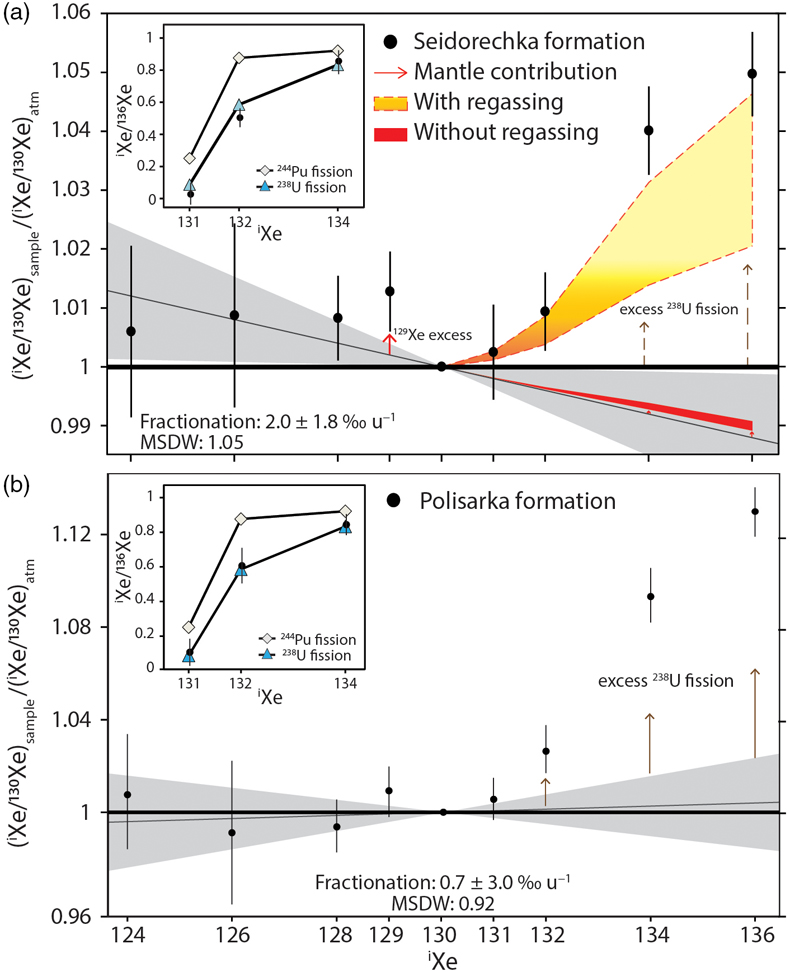
Figure 1 Isotopic spectrum of Xe released from fluid inclusions in (a) sample FD1A and (b) sample FD3A. The grey line and its associated envelope (2σ) correspond to the isotopic trend of the 124,126,128,130Xe. (a) Mantle excesses of 131,132,134,136Xe are estimated using the 129Xe excess (Supplementary Information). Individual error bars are at 2σ.
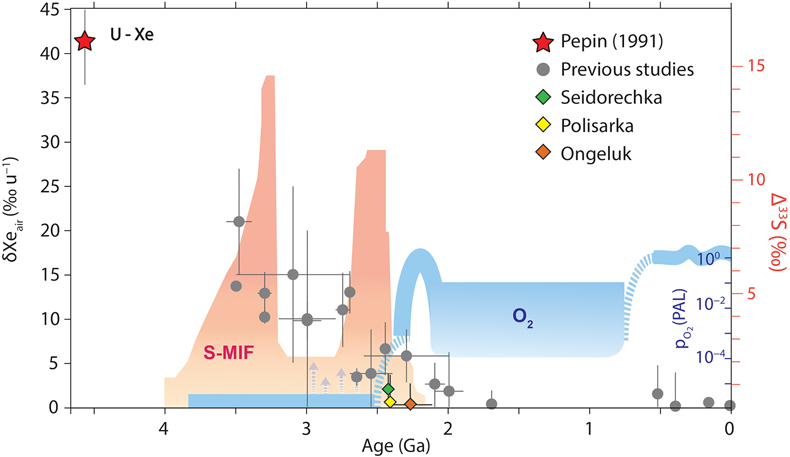
Figure 2 Records of atmospheric oxygen (O2, blue; Lyons et al., 2014
Lyons, T.W., Reinhard, C.T., Planavsky, N.J. (2014) The rise of oxygen in Earth’s early ocean and atmosphere. Nature 506, 307–315. https://doi.org/10.1038/nature13068
), mass-independent fractionation of sulfur isotopes (MIF-S, orange; data from Killingsworth et al., 2019Killingsworth, B.A., Sansjofre, P., Philippot, P., Cartigny, P., Thomazo, C., Lalonde, S.V. (2019) Constraining the rise of oxygen with oxygen isotopes. Nature Communications 10, 4924. https://doi.org/10.1038/s41467-019-12883-2
) and mass dependent fractionation of xenon isotopes throughout Earth’s history (Pepin, 1991Pepin, R.O. (1991) On the origin and early evolution of terrestrial planet atmospheres and meteoritic volatiles. Icarus 92, 2–79. https://doi.org/10.1016/0019-1035(91)90036-S
; Avice et al., 2018Avice, G., Marty, B., Burgess, R., Hofmann, A., Philippot, P., Zahnle, K., Zakharov, D. (2018) Evolution of atmospheric xenon and other noble gases inferred from Archean to Paleoproterozoic rocks. Geochimica et Cosmochimica Acta 232, 82–100. https://doi.org/10.1016/j.gca.2018.04.018
; Almayrac et al., 2021Almayrac, M.G., Broadley, M.W., Bekaert, D.V., Hofmann, A., Marty, B. (2021) Possible discontinuous evolution of atmospheric xenon suggested by Archean barites. Chemical Geology 581, 120405. https://doi.org/10.1016/j.chemgeo.2021.120405
), uncertainties are at 2σ.


